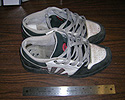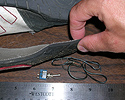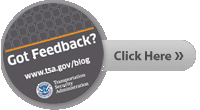
Here are the top ten questions we received from our recent request. We tallied the number of times we received each question or a similar version of it and noted the total for each question below. Thanks to the Office of Chief Counsel, Privacy Office and Kip for helping us provide you with the answers.
10) What immediate measures can a person take when encountering a less than friendly TSA agent? 12 of our readers asked this question.First, you can request a lead or supervisor. If you're not satisfied after speaking with a lead or supervisor, you can request a manager. If you're in a hurry and don't have time to talk, or if you are not comfortable making your complaint in person, you can visit our new
Got Feedback? web page. "Got Feedback?" is a new program that allows passengers to contact us via e-mail with very specific questions, comments, complaints, etc. Rather than your e-mail being sent to a single mail box where it sits in the queue waiting for a response, it is actually sent directly to the TSA Customer Support Manager at the airport your feedback concerns. Upon request, the Customer Service manager will contact you.
Click here to read more about the "Got Feedback?" program.Our officers have a tough job, and they are there to protect you and your family. Everyone at TSA appreciates the support of the traveling public, including those who express their support with their courteous behavior and words of support.
9) Do any members of the Blog team actively perform screening functions? 12 of our readers asked this question.Not currently. When Bob joined the blog team, he was a Behavior Detection Officer based out of Cincinnati and a former Transportation Security Officer who performed screening duties. Bob eventually came to headquarters as a full-time blog team member. So, while Bob has 5 ½ years experience in
various screening functions, he is no longer a TSO/BDO.
While not in a screening function, Jay is a Federal Security Director for an airport in the Midwest. He oversees screening operations at about 10 airports of varying sizes. Also,
we had a TSO contribute as a guest blogger and write an article on Checkpoint Evolution.There are currently many TSOs and other field employees actively involved commenting on the blog, and we appreciate their participation.
We will continue to invite members of the workforce to weigh in on the blog to keep it relevant to what is happening in airports. The blog will improve as we add new folks with various areas of expertise.
8) Why do you have access to my political affiliation? 13 of our readers asked this question.
"It's unequivocally not our policy to use political, religious, or other sensitive personal topics as identity validation. If it happened, it was wrong and will not be repeated." Administrator Kip Hawley
Perhaps you're asking this question because of a recent story about a person who said that their identity was verified at a checkpoint by asking their political affiliation. Early on, there was a case where the operations call center ran a passenger's information through their database (which includes commercial data) for a passenger without ID, and found no significant information to verify their identity. One thing that did come up was political donations for a person with the same name. Political donations are a matter of public record and accessible to anyone with basic Internet search skills. As a last ditch effort to help the passenger, a decision was made to ask them about their political affiliation. It was a mistake.
7) Why has TSA restarted the pointless gate screening? If the sterile area is in fact sterile, there's no need to screen those who have already been screened. 13 of our readers asked this question.In reality, we do very little screening of bags at gates. We do, however, conduct a great deal of additional security in the sterile area. For instance, we have Behavior Detection Officers and K-9 teams on regular patrols as well as undercover Federal Air Marshals throughout the sterile area. Not to mention video coverage. We want to pick up on people who may be doing surveillance or attempting to prepare for a later attack. We are interested in activity around gates, but also restaurants, Duty Free shops, and other common areas.
As to gate screening itself, we have special purpose checks for specific items and behaviors. We may also have a particular interest in different flights. We layer in some random activities so as not to raise attention when we do have a specific interest. You may see our inspectors with new portable explosives detection devices that go onboard an aircraft ahead of boarding and check employees with access to the aircraft, including catering.
TSA’s overall strategy is to incorporate mobile, unpredictable, intelligence-driven security measures in ways that frustrate a terrorist planner seeking to engineer attacks against an easier, stationary target. We do not, as the question suggests, do gate screening of bags merely to re-do what we already did at the checkpoint.
Click here to watch a short video on gate screening.6) I had a TSA agent tell me that each airport is free to implement security standards beyond those listed on the TSA site -- meaning that they could restrict items from being allowed in carry-on baggage that are explicitly allowed according to the TSA site. 14 of our readers asked this question.There is a standard list of prohibited items that is available on our Web site to anybody with an internet connection, including terrorists. Clearly we have to pay attention to those items, since they are obvious tools of would-be attackers.
We cannot, however, fixate on those items and think that if we stop them, we're safe. Terrorists know TSA's standard operating procedures and work on how to engineer around them. Look no further than the August '06 London bomb plot with liquid sports drinks. If those terrorists had made it to the checkpoint, many of the items they were bringing would have been extremely hard to identify.
TSA is moving the focus of our officers from a checklist mentality to an empowered environment where officers use their experience and training -- and trust their instincts. The TSA workforce has screened more than 3 billion people, about half the population of the earth. We have a good handle on what "normal" looks like. Anything out of the "normal" range may get additional scrutiny, whether or not it is on the prohibited items list. That could mean a variety of things from a more thorough physical search to a seemingly casual conversation. It depends on what the anomaly might be. We know that with many layers of security the thinking, engaged and experienced TSO will be the one to stop an attack.
TSA is committed to using the judgment and experience of our officers to keep the security advantage. TSA is embarking on a two-day training for all officers that will tie together the latest intelligence analysis, more advanced explosives detection skills, and ways to engage with passengers in a way that promotes a calmer environment and better security result. It uses the physical checkpoint to our advantage to improve security.
5) Why doesn't TSA consider items being stolen from checked bags a security threat? Dangerous items could just as easily be ADDED to luggage. 15 of our readers asked this question.We do! We consider every opportunity for someone to get a weapon or a bomb onto a plane and use a variety of methods to ensure there's something in place to mitigate that threat.
Specifically, there are video monitoring systems in places where individuals have access to checked bags, both airline baggage handling areas and TSA inspection stations.
Beyond that, we have a
multi-layered approach to security, because if one layer gets breached, another layer or layers can step in to fill the gap. Let's focus on layers that directly affect your question.
TSA does background checks on and issues credentials to all employees who work in the secure area of the airport – which includes people handling baggage. TSA also conducts random employee screening every day in airports to ensure only people with proper and valid credentials get into the secure area.
TSA initiates internal investigations or ‘stings’ if we have a concern. When caught, arrests are made and serious federal charges are brought. Also, behavior detection officers are trained to spot suspicious behavior anywhere in the airport.
It's also important to note that employees who work in the airport often see the same people day in and day out, and know when something doesn't seem right. While they don't always work for TSA, they are another set of eyes and ears keeping watch for your safety.
4) Where is the Privacy Impact Assessment for the form that TSA provides to people who claim to be unable to present credentials at TSA airport checkpoints? 15 of our readers asked this question.The Privacy Impact Assessment, or PIA, that covers the information collection and handling associated with identity verification is the
Operations Center Information Management System PIA. Identity verification is one of several types of information associated with airport security efforts that fall within the coverage of this PIA.
For bonus points, we'll answer another question that some have asked: whether the form itself requires an OMB control number. Since the form entails no burden beyond identifying the individual and home address, it is exempt from Paperwork Reduction Act requirements pursuant to 5 CFR 1320.3(h)(1).
3) Given that it's trivially easy to forge a boarding pass, how does presentation of validated IDs do anything to ensure that people on selectee/no-fly lists don't enter the sterile area? 16 of our readers asked this question.An excellent question. TSA's document checkers are looking at IDs and boarding passes. They are aware of the techniques that forgers use and are looking out for them. We are working with the airlines both in the U.S. and world-wide on this issue. There are encryption and other methods of validating a boarding pass. Some are sophisticated, some are very low-tech and simple. Some airlines are now using encrypted electronic boarding passes that appear on a passenger's cell phone or PDA. The
International Air Transport Association, which secures international cooperation and uniformity in aviation regulations and standards, is moving all of its members to use this technology by the end of 2010.
Even so, it is important to remember that the different layers of security work together. We're not only checking IDs and boarding passes at the checkpoint, we have measures throughout the airport, at the gate, and on the aircraft, that identify someone who may be dangerous.
Lastly, one of the other Top Ten questions dealt with random gate screening, which is another way of closing the loophole. The random check can also be used to ensure additional security measures when our information suggests it is warranted.
2) In the context of ensuring air travel safety, what is the difference between two people, both of whom are willing to cooperate with TSA's invasive interrogations, one of whom politely declines to show ID, the other of whom claims he lost or misplaced his ID? 20 of our readers asked this question.
Bottom line is identity matters. We need to verify who is getting on the plane.
The best and quickest way for us to assure identity is with a photo ID
issued by a federal or state government. We work with passengers who have something less than that, including no ID. Most passengers in that situation help us quickly resolve the matter by sharing whatever information they have, sometimes verified through our Ops Center in Virginia. Someone declining to show an ID that they have on them endures a lot of hassle for not much of a point since it is far more intrusive for us to resolve it through the Ops Center than showing a legitimate ID up front. It is only when someone refuses to identify themselves or attempts to use fake ID that we would deny entry to the sterile area based on ID.
Ever since airport security started decades ago, it was based on "things" – making sure a bad thing like a gun or a bomb didn't get on a plane. Problem is, terrorists kept finding new ways to disguise their tools to be almost identical to ordinary objects; most recently, bottles of sports drinks and batteries with explosives inside. They will continue to find more novel threats. That is why the additional layer of identity verification matters more now than ever. Watch lists are a valuable tool in keeping people with known ties to terror plotting off planes.
1) TSA cites 49 C.F.R. § 1540.107 and 1540.105(a)(2) as the law giving them authority to demand identification as a condition of granting access to a sterile area of an airport. 49 C.F.R § 1540.5 appears to limit such passenger screenings to searches for weapons, explosives, and incendiaries as the only requirement for granting access to the sterile area. How does TSA reconcile this conflict? 27 of our readers asked this question.
There is no conflict to reconcile. It is true that 49 C.F.R Section 1540.5 describes screening functions and screening locations in terms of the inspection of individuals and property for weapons, explosives, and incendiaries. However, 49 C.F.R. Section 1540.105(a)(2) doesn't use the word 'screening' at all. Section 1540.105(a)(2) simply states that persons may not enter the sterile area without complying with the systems, measures, or procedures being applied to control access to that area. TSA's identification requirement is one such system, measure or procedure that is used to determine who is permitted to access the sterile area.
By citing 49 C.F.R. § 1540.107 in our original post, we were trying to illustrate one of the ways (and indeed, the most visible way) in which TSA has used its statutory authority to establish security procedures at airports. But, it's important to note that TSA's responsibility for aviation security is not just limited to checkpoint screening. TSA has broad authority to develop policies, strategies, and plans for dealing with the changing threats to aviation security. See, for example, 49 U.S.C. §§ 114(d) and (f) (addressing TSA functions, duties, and powers); id. § 114(h) (addressing notification procedures concerning persons who may pose risk of air piracy or terrorism or a threat to the airline or passenger safety). This authority is in addition to TSA's responsibility for the screening of passengers and property. See, for example, 49 U.S.C. §§ 114(e) (addressing screening operations), 44901(a) (addressing screening of passengers and property).
Thanks,
Bob
EoS Blog Team
Labels: legal issues, mission, policy, questions









